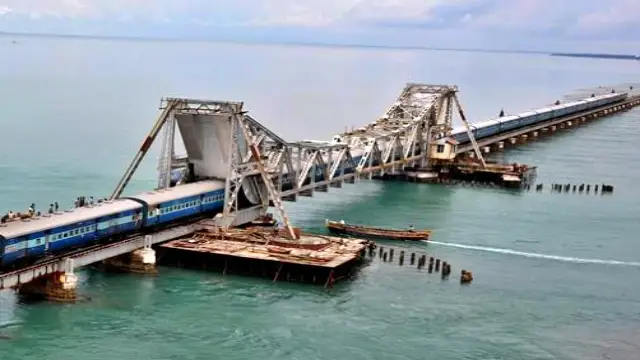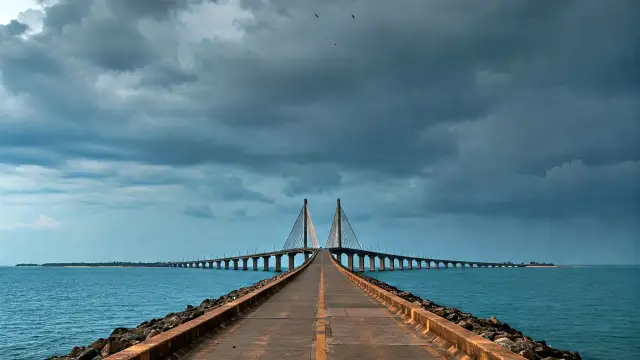Pamban Bridge: Where Engineering Meets the Sea
Ever seen a bridge that opens up to let ships pass? Welcome to Pamban Bridge India’s first sea bridge and an engineering marvel that’s stood the test of time (and cyclones). Stretching gracefully over the turquoise waters of the Palk Strait, this bridge isn’t just a lifeline for Rameswaram Island it’s a legend.
But what makes it so special? Why do travelers and engineers alike rave about it? Let’s dive in.

A Bridge Born from Necessity
Before 1914, reaching Rameswaram a sacred island in Tamil Nadu was a hassle. Ferries were the only option, and let’s be real, they weren’t exactly reliable. Then came Pamban Railway Bridge, India’s first sea bridge, connecting Pamban Island to the mainland.
- Opened: February 24, 1914
- Length: 2.065 km (6,776 ft)
- Record Holder: Longest sea bridge in India until 2010 (when Bandra-Worli stole the title).
For 74 years, this was the only surface link to Rameswaram. Imagine that no roads, just trains chugging over the sea.
The Ingenious Design: How It Works
This isn’t your average bridge. Pamban Bridge has a bascule section a fancy term for a moving part that lifts up. Why? Because ships need to pass, and a static bridge just won’t cut it.
- Manual Operation: Workers use levers to raise the two leaves (each weighing 415 tonnes).
- Corrosion Challenge: Built in the world’s second-most corrosive environment (after Florida). Saltwater eats metal, so maintenance is constant.
- Wind & Cyclones: Located in a high-wind zone, it’s survived multiple storms (but not without scars).
Fun fact? The bridge stands 12.5 meters (41 ft) above sea level high enough to avoid most waves but low enough to feel the ocean’s spray.

The Tragic Side: Storms & Accidents
The bridge faced damage during the devastating Rameswaram cyclone of 1964, necessitating repair work. In 2009, under the guidance of E. Sreedharan, strengthening efforts were carried out to prepare the bridge for carrying goods trains. Fast forward to 13 January 2013, the piers of the bridge needed repairs after sustaining minor damage caused by a drifting naval barge. Then, in 2016, the Ministry of Railways allocated ₹25 crore (roughly US$3.9 million) for upgrading the span. The plan was to replace the 65.23-meter (214-ft) rolling-type span with a 66-meter (217-ft) single truss span that could be opened automatically.
Another tragic event tied to the region occurred on 23 December 1964, when an estimated 25-foot (7.6-meter) storm surge hit the island. This catastrophe overturned the Pamban-Dhanuskodi passenger train, tragically claiming the lives of all 150 passengers. As for the bridge itself, its brushes with misfortune continued, suffering minor damage from the same drifting naval barge in January 2013.
Later mishaps:
- 2013: A naval barge drifted into the bridge, damaging piers.
- 2016: ₹25 crore was sanctioned to replace the old lifting span with an automated one.
Yet, despite everything, the bridge still stands.
The Road Bridge: Making Life Easier
By 1988, trains weren’t enough. India needed a road link. Enter the Annai Indira Gandhi Road Bridge, running parallel to the railway.
- Inaugurated by: PM Rajiv Gandhi (October 2, 1988)
- Length: 2.345 km
- Construction Time: 14 years (patience pays off).
Now, cars and bikes zip across, while trains rumble beside them.
Why Pamban Bridge Still Matters
- Historical Significance: First sea bridge in India that’s a bragging right.
- Engineering Feat: Manual lifting mechanism in a corrosive, cyclone-prone zone? Respect.
- Lifeline for Rameswaram: Without it, pilgrims and locals would still be stuck on boats.
But is it dangerous? Well, it’s been called India’s most dangerous bridge thanks to storms and age. Yet, millions cross it yearly, trusting in its steel and sweat.
Final Thought: More Than Just Steel & Concrete
Pamban Bridge isn’t just infrastructure it’s a story. Of ambition, survival, and human ingenuity. Next time you see a photo of it, remember: this bridge moves, it survives, and it connects not just land, but people.
So, would you dare to cross it?


Wow, the Pamban Bridge is such an incredible feat of engineering and history! It’s amazing to think about how it has connected Rameswaram to the mainland for over a century. Stories like this make you appreciate the vision and determination that goes into creating infrastructure that stands the test of time.
Pamban Bridge is truly a marvel of engineering and history, Connecting Rameswaram Island to the mainland for over a century, its incredible how such structures stand as a testament to human ingenuity. This bridge isn’t just functional, it’s a part of India’s heritage.
Wow, what an incredible piece of history and engineering! It’s fascinating to learn about the Pamban Bridge being India’s first sea bridge. The image of the train traversing over the water connecting to Rameswaram Island is just breathtaking. You really captured the significance of this bridge, not just as a means of transport but as a vital link and a symbol of connection. I can only imagine the views from the train – must be an unforgettable experience! Thanks for sharing this insightful post. It definitely makes me want to add this to my list of places to visit.